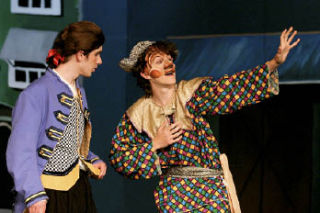Barbara Hume’s primary direction to her Bainbridge High School actors this fall has been to “play with the lazzi.”
The Italian term, referring to a funny interruption, plays an important role in the centuries-old Italian theater genre Commedia dell’ Arte, in which plot takes a back seat to playful improvisation and zany onstage antics.
“We’ve never attempted a Commedia dell’ Arte type play, so I thought, why not start at the beginning of comedy?” Hume said.
So for her first production as the new Bainbridge High School theater director, Hume chose Carlo Goldoni’s “The Servant of Two Masters,” which opened last night and runs this weekend and next.
In addition to the abundance of lazzi, Commedia dell’ Arte possesses four main character types – or after all this time, archetypes: the silly old Pantalone, often an innkeeper or shopkeeper; the absent-minded or self-important Doctor; the boastful and rakish Captain; and the sometimes-plotting, sometimes-foolish Harlequin, on whom the plot and many of the jokes pivot.
The genre had a 300-year run that ended in Goldoni’s 18th century. Over the decades and centuries, the character types, as well as their lines and gestures and the specifics of the lazzi, morphed to reflect current events and the mores of the time.
By the time Goldoni penned “Servant” in 1753, Commedia dell’ Arte was on its way out; it was a swan song, of sorts.
“Goldoni is celebrating the end of this genre,” she said.
Of course, revivals of the genre came and went, as revivals do, and Jeffrey Hatcher and Paolo Landi updated “Servant” with a translation aimed at modern audiences. One of the things that makes the translation not only smart but true to form, Hume said, are its modern inside jokes and contemporary colloquialisms. That flavor, after all, is what Commedia dell’ Arte has always been all about.
And it’s what has rendered the material both accessible and hilarious to the student actors from the start.
“The kids loved it when the read through it – they were laughing hysterically,” she said.
Examples include a gag about product placement featuring a wonder-tonic called “Fricandeau” (say it out loud, it’s funny) as well as running jokes about the ongoing financial struggle of being in the theater.
With this lighthearted approach, “The Servant of Two Masters” offers a celebration of the sheer fun of student theater. And in selecting the fall play, Hume was mindful of what would resonate with the actors, purposely avoided material that employed, say, the heavily analytical Stanislavski method.
The physicality was appealing, too; Hume said the actors have gotten increasingly into the improvisational gesticulations and back-and-forth that are the hallmarks of Commedia dell’ Arte. Not only have they learned to play off each other – and try new things with each run-through – but they’ll also have the opportunity to play off the audience, drawing from its energy performance after performance.
Case in point: a self-referential break in Act One in which Smeraldina, the sardonic maid, addresses the audience with a quick pop-quiz to ensure its understanding of the fast-paced story.
“Here, have a mint,” she says, throwing candy at the audience, whether anyone responds or not.
Hume, who has been a BHS English instructor for 15 years, also has a background in dance, choreography, singing, acting and musical theater. So while this is her first stint as BHS theater director, and her first foray with this age group, she’s relishing the opportunity to stretch her theatrical muscles once again, and to introduce a new generation to a beloved art form.
“We’re all in process,” she said. “I’ve got my learning curve. I’m right there with them. I’m very empathic.”



